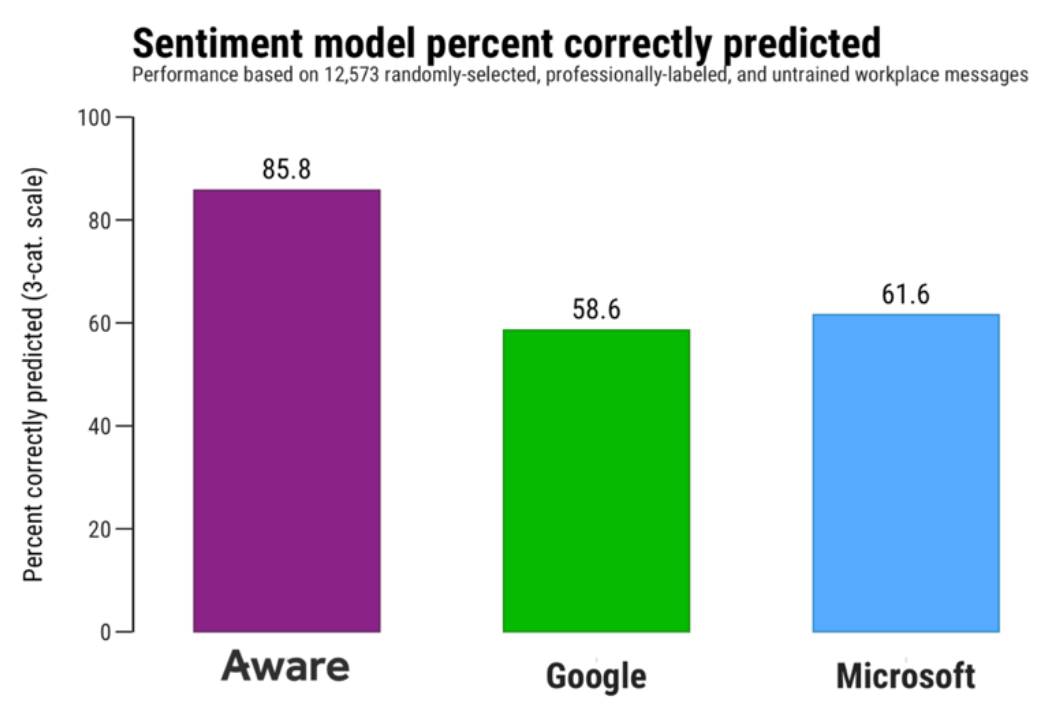3 Ways Savvy Business Leaders are using AI Right Now
by Aware
Discover how businesses are protecting the bottom line, securing their data, and unlocking accelerated growth using industry-leading employee listening AI insights from Aware.
Artificial intelligence is the latest hot trend to impact big business, but how much of the hype is actionable in the real world? Generative AI models like Chat-GPT held so much promise for transforming the way we research, prospect, and communicate, but anyone who’s asked a large language model (LLM) to write professional copy knows the output doesn’t deliver.
Then there are the security considerations of entering your company’s data into a model that can’t tell you what it does with that information. That’s why business leaders should think twice about generative AI—but it isn’t the only form of artificial intelligence on the market. Smart business leaders are instead turning to Aware’s purpose-built contextual AI data platform for authentic insights into their workplace driven by carefully curated data, committed to your information security, and informed by best-in-class proprietary natural language processing (NLP).
What is artificial intelligence?
Forget the science fiction. AI isn’t a self-aware, self-educating machine brought to life. It’s a series of algorithms and models that make decisions based on data inputs. Generative LLMs, for example, are predictive models that anticipate the next step in a sequence based on pattern recognition.
AI models are trained on vast amounts of data so they can understand patterns at a high level, in things like language, art, and human behavior. The quality of output the model produces is highly dependent on the quality of the data it ingests. The more closely the data is curated, the more specific the results become. For example, a generative AI could ingest thousands of famous paintings and create its own version of a particular style, but it couldn’t identify cancer on a scan. For that use case, you need a highly specialized model that has been trained to do nothing but read scans and detect cancer.
Aware’s AI models were purpose-built to understand the nuances of short-form collaboration messages like those in Slack, Teams, and Zoom Team Chat. Underpinning everything is our proprietary natural language processing (NLP), a model with near-human accuracy that continually ingests data to produce the most accurate sentiment scoring available today. That gives our contextual AI data platform the ability to extract authentic, actionable insights from aggregate employee voices in real time, giving business leaders a continuous understanding of what is happening at every level of their company.
Business use cases for artificial intelligence
Many of the uses suggested for Chat-GPT and other generative AI models fail to live up to expectations because they weren’t built for those use cases. There are better solutions that perform specific tasks extremely well, because that’s all they were created to do. And right now, the world’s leading companies are using those AI models to transform the ways they do business.
AI Use Case 1: Sentiment scoring to detect toxicity
Workplace sentiment fluctuates on a daily basis depending on countless variables—the day of the week or time of year, internal changes like promotions or layoffs, and even the weather can impact the overall sentiment of your employees. For the most part, these fluctuations are normal and harmless. What isn’t harmless is toxic behavior.
A toxic employee can create risk for companies in a number of ways, including:
- Reducing morale across the workforce
- Negatively impacting performance and productivity
- Accelerating turnover by alienating good employees
- Deliberately sabotaging products or exfiltrating IP
- Putting the company at risk of fines, penalties, and lawsuits
Aware’s NLP beats all leading competitors at accurate sentiment scoring, normalized for each individual workplace. That gives business leaders a real-time pulse on the sentiment of their organization, and shines headlights into the dark corners where toxicity festers.

Using Aware, one social enterprise foundation addressed and resolved reports of increased harassment between employees within their workplace collaboration tools. Aware’s NLP quickly surfaced potentially toxic and harassing messages—with full context—which led to the discovery that one employee threatening a lawsuit was actually the instigator in a number of harassing incidents.

Read the case study: Actively Reducing Harassment in the Workplace
AI Use Case 2: Theme and keyword detection to track equipment outages
Machine outages can cost companies a fortune in lost sales, decreased productivity, and reputational damage. Customers can’t get the products or services they expect, and sentiment falls as employees deal with increased complaints or lose shifts because there’s no work to do.
How does your business currently handle identifying, remediating, and tracking equipment downtime? For most companies, it’s a laborious process that adds complexity and breeds dissatisfaction.
One global restaurant franchise turned to Aware to solve the problem. Their original repair process took up to seven days to identify and validate outages and restricted how equipment problems were reported. With Aware, the company was able to establish a series of theme and keyword detection rules that automatically identified equipment failures mentioned by any employee in their Workplace from Meta collaboration tool, dramatically reducing the speed and complexity of reporting outages.

Read the case study: Reducing Costly Equipment Downtime Through Proactive Monitoring
AI Use Case 3: OCR and regex detection to protect regulated information
Company collaboration tools like Slack and Teams are packed with sensitive and confidential data. From product development and strategy ideas to HR discussions and talks about potential investments and mergers, office chat tools are full of IP and other restricted information. What most businesses don’t realize is that alongside that information is a trove of regulated and restricted data that, if it leaked, would open the business up to fines, penalties, and lawsuits.
- Protected Health Information (PHI) — regulated under HIPAA
- Payment Card Industry (PCI) data — regulated by the PCI Standards Security Council
- Personally Identifying Information (PII) — regulated under GDPR, CCPA/CPRA and similar
Aware’s machine learning models are trained to detect a wide range of regulated and sensitive information types by recognizing regular expressions (regex) such as Social Security Numbers, zip codes, and dates of birth. Using this functionality, a major telecom provider discovered their call center employees were using Slack to store thousands of customer credit card numbers. That has catastrophic implications when PCI DSS noncompliance fines can run up to $100,000 per month.
Thanks to Aware, the company was able to identify the problem, remove the noncompliant content, and retrain employees on how to use Slack and other collaboration tools. To prevent repeat violations in the future, Aware automatically detects and removes PCI data from the company’s Slack messages in real time.

Read the case study: Helping a Telecom Provider Investigate and Safeguard Confidential Data
Learn more about contextual AI from Aware
Aware’s AI data platform unleashes the full power of artificial intelligence to augment and improve existing business processes using data from their existing collaboration tools. Built and trained for this specific dataset, Aware offers best-in-class results across a range of AI/ML and natural language processing models created to support modern business needs.
Learn more about Aware’s AI and how it’s transforming the future of work.








